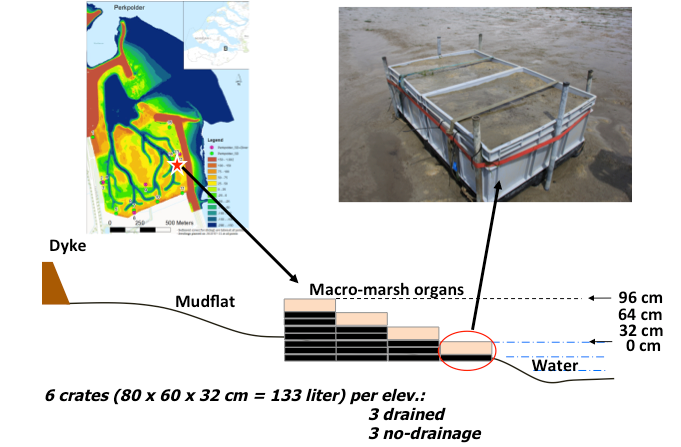
A mesocosm study has been carried out to quantify the effect of sediment-type (Perkpolder sediment vs. sediment collected at two locations in Rammegors) and drainage on seedling survival. The results show that poor drainage reduce the seedling survival at Perkpolder (figure 1). The detailed results are available in a student report from Annick van der Laan (University Utrecht).
Mega-marsh organ experiments

Mega-marsh organs were placed at Perkpolder for carrying out controlled field experiments (figure 2). Because of a delay the first seedlings could only be planted in august, which is a bit late in the season. Nevertheless the late start, the experiment does provides good insights in the seedling survival of different species along the elevational gradient and in response to soil drainage.
The survival in the first week shows us that:
- taller plants have a better chance to survive (see three size classes for Spartina figure 3)
- less salt tolerant species (e.g., Phragmites) survive poorer than more salt tolerant species (e.g., Spartina; figure 3)
- survival tends to increase with increasing elevation (e.g. Puccinellia; figure 3) and with drainage (e.g., Spartina; & Puccinellia; figure 3)
These results are however highly preliminary, and have not yet been statistically tested, and only represent the survival after one week. So no firm conclusions should be drawn, other than that the mega-marsh organ experiment is up and running.

- Perkpolder tidal restauration, one year after realisation, draft progress report, Boersema, M., J. van der werf, P. de Louw, T. Ysebaert, T. Bouma, Centre of expertise Delta Technology, 27 november 2016.
Zie ook
- Perkpolder tidal restauration, one year after realisation, draft progress report
- Rammegors tidal restauration, final report
- Perkpolder Tidal Restauration
- Biogeomorphology of Spartina anglica tussocks, GIS based comparison of contrasting sites at the Westerschelde and Blackwater estuary
- The effects of biogeochemical stressors on seagrass ecosystems
- Short-term mudflat dynamics drive long-term cyclic salt marsh dynamics.
- Eelgrass (Zostera marina L.) in the western Wadden Sea: monitoring, habitat suitability model, transplantations and communication
- Ecosystem recovery after hypoxia: what can foraminifera indicate?
- Building with Nature; from concepts to practice
- The Benthic Ecosystem Quality Index (BEQI), intercalibration and assessment of Dutch coastal and transitional waters for the Water Framework Directive. Final report






